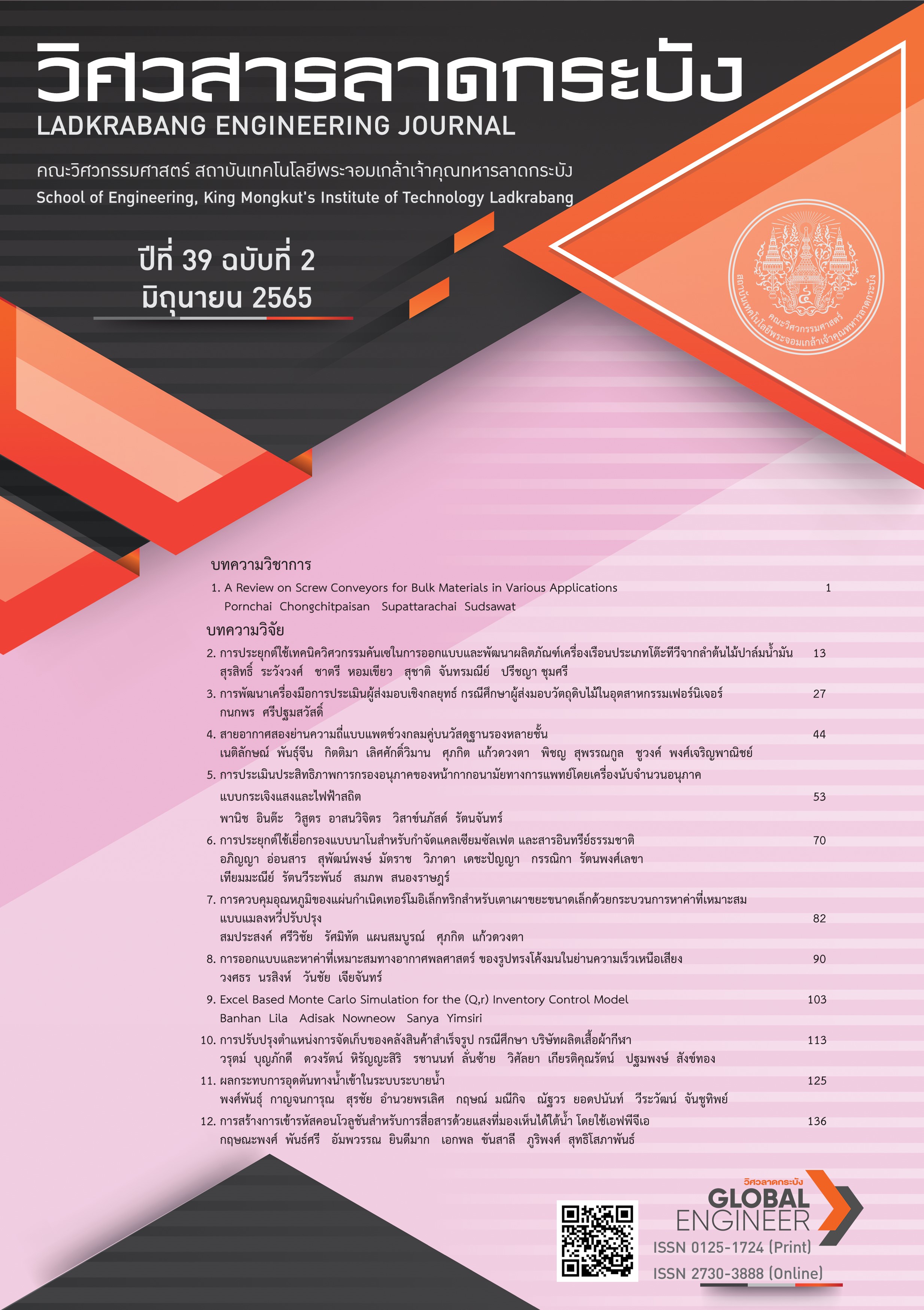Application of Nanofiltration Membrane for Calcium Sulfate and Natural Organic Matter Removal
Keywords:
Nanofiltration membrane, Ionic strengths, Calcium sulfate, Natural Organic Matter (NOM), Flux declineAbstract
The objective of this research was to study the removal efficiency of calcium sulfate and natural organic matter (NOM) using nanofiltration membrane. The membrane sheets used were obtained from GE Water & Process Technologies (model HL4040HM). The filtration experiments were determined by a dead-end filtration membrane. Factors studied were ionic strengths of calcium sulfate, pH and combined effects between calcium sulfate and NOM. The experimental results revealed that increased ionic strengths of calcium sulfate provided higher flux decline, possibly increased concentrations of calcium sulfate, thus decreased permeate flow. Solutions having high ionic concentration of 0.015 M resulted in the highest sulfate removal about 97%, thus enhancing accumulation of calcium sulfate on the membrane surface. The pH effects caused calcium and sulfate removal ranging from 71% to 93 %. For combined effects between calcium sulfate and NOM, it was found that fluxes and rejection efficiencies (both calcium and sulfate rejections) showed lower values than those without NOM.
References
C. Pelekani, G. Newcombe, V. L. Snoeyink, C. Hepplewhite, S. Assemi and R. Beckett, “Characterization of natural organic matter using high performance size exclusion chromatography,” Environmental Science & Technology, vol. 33, no. 16, pp. 2807–2813, 1999, doi: 10.1021/es9901314.
S. Crittenden, R. Reifenberger, J. Hillebrecht, R. Birge, D. Inerowicz and F. Regnier, “Soft lithography based micron-scale electrophoretic patterning of purple membrane,” Journal of Micromechanics and Microengineering, vol. 15, no. 8, pp. 1494–1497, 2005, doi: 10.1088/0960-1317/15/8/016.
World Health Organization (WHO). Guidelines for Drinking–water Quality. 4th Edition. Geneva: WHO Press, pp. 427–430, 2012
T. K. Nissinen, I. T. Miettinen, P. J. Martikainen and T. Vartiainen, “Molecular size distribution of natural organic matter in raw and drinking waters,” Chemosphere, vol. 45, no. 6, pp. 865–873, 2001, doi: 10.1016/S0045-6535(01)00103-5.
A. Contreras, A. Kim and Q. Li, “Combined fouling of nanofiltration membranes: Mechanisms and effect of organic matter,” Journal of Membrane Science, vol. 327, pp. 87–95, 2009, doi: 10.1016/j.memsci.2008.11.030.
B. M. Watson and C. D. Hornburg, “Low-energy membrane nanofiltration for removal of color, organics and hardness from drinking water supplies,” Desalination, vol. 72, no. 1–2, pp. 11–22, 1989, doi: 10.1016/0011-9164(89)80024-4.
I. C. Escobar and A. A. Randall, “Influence of NF on distribution system biostability,” Journal AWWA, vol. 91, no. 6, pp. 76–89, 1999, doi: 10.1002/j.1551-8833.1999.tb08650.x.
S. J. Duranceau, J. S. Taylor and L. A. Mulford, “SOC Removal in a Membrane Softening Process,” Journal AWWA, vol. 84, no. 1, pp. 68–78, 1992, doi: 10.1002/j.1551-8833.1992.tb07287.x.
J. S. Vrouwenvelder, J. W. N. M. Kappelhof, S. G. J. Heijrnan, J. C. Schippers and D. van der Kooija, “Tools for fouling diagnosis of NF and RO membranes and assessment of the fouling potential of feed water,” Desalination, vol. 157, no. 1, pp. 361–365, 2003, doi: 10.1016/S0011-9164(03)00417-X.
G. V. Haute, E. Caberlon, E. de Mesuita, F. C. Pedrazza, L. Martha and B. A. de Oliveira, “Gallic acid reduces the effect of LPS on apoptosis and inhibits the formation of neutrophil extracellular traps,” Toxicology in Vitro, vol. 30, no. 1, pp. 309–317, 2015, doi: 10.1016/j.tiv.2015.10.005
K. Tyrpien, C. Dobosz, A. Chosciewice, A. Ciolecka, M. Wielkoszynski, T. janoszka and D. Bodzek, “Investigation of nicotine transformation products by densitometric TLC and GC–MS,” Acta Chromatographica, vol. 13, pp. 154–160, 2003.
N. M. Al-Bastaki, “Performance of advanced methods for treatment of wastewater: UV/TiO2, RO and UF,” Chemical Engineering and Processing: Process Intensification, vol. 43, no. 7, pp. 935–940, 2004, doi: 10.1016/j.cep.2003.08.003.
M. Bystrianský, O. Nir, M. Sir, Z. Hongsajkova, R.Vurm, P. Hrychova and B. Van der Bruggen, “The presence of ferric iron promotes calcium sulphate scaling in reverse osmosis processes,” Desalination, vol. 393, pp. 115–119, 2016, doi: 10.1016/j.desal.2016.03.003.
C. Charoenssuk, S. Mattaraj, K. Ratanapongleka and C. Jarusutthirak, “Effects of Natural Organic Matter and Carbonate Salts on the Operation of Nanofiltration Membrane,” Journal of Industrial Technology of Thailand, vol. 5, no. 2, pp. 26–37, 2015.
P. Wu and M. Imai, “Novel biopolymer composite membrane involved with selective mass transfer and excellent water permeability,” in Advancing Desalination, London, United Kingdom: IntechOpen, 2012, ch. 3, pp. 57–82.
J. Decarolis, S. Hong and J. Taylor, “Fouling behavior of a pilot scale inside-out hollow fiber UF membrane during dead-end filtration of tertiary wastewater,” Journal of membrane science, vol. 191, no. 1–2, pp. 165-178, 2001, doi: 10.1016/S0376-7388(01)00455-0.
J. E. Kilduff, S. Mattaraj and G. Belfort, “Flux decline during nanofiltration of naturally-occurring dissolved organic matter: effects of osmotic pressure, membrane permeability, and cake formation,” Journal of membrane science, vol. 239, no. 1, pp. 39–53, 2004, doi: 10.1016/j.memsci.2003.12.030.
N. Park, S. Lee, S. R. Yoon, Y. H. Kim and J. Cho, “Foulants analyses for NF membranes with different feed waters: coagulation/sedimentation and sand filtration treated waters,” Desalination, vol. 202, no. 1–3, pp. 231–238, 2007, doi: 10.1016/j.desal.2005.12.060.
W. Saikaew, S. Mattaraj and R. Jiraratananon, “Nanofiltration performance of lead solutions: effects of solution pH and ionic strength,” Water Supply, vol. 10, no. 2, pp. 193–200, 2010, doi: 10.2166/ws.2010.062.
A. Lhassani, M. Rumeau, D. Benjelloun and M. Pontie, “Selective demineralization of water by nanofiltration application to the defluorination of brackish water,” Water research, vol. 35, no. 13, pp. 3260–3264, 2001, doi: 10.1016/S0043-1354(01)00020-3.
Downloads
Published
How to Cite
Issue
Section
License
Copyright (c) 2022 Faculty of Engineering, King Mongkut’s Institute of Technology Ladkrabang

This work is licensed under a Creative Commons Attribution-NonCommercial-NoDerivatives 4.0 International License.
The published articles are copyrighted by the School of Engineering, King Mongkut's Institute of Technology Ladkrabang.
The statements contained in each article in this academic journal are the personal opinions of each author and are not related to King Mongkut's Institute of Technology Ladkrabang and other faculty members in the institute.
Responsibility for all elements of each article belongs to each author; If there are any mistakes, each author is solely responsible for his own articles.






